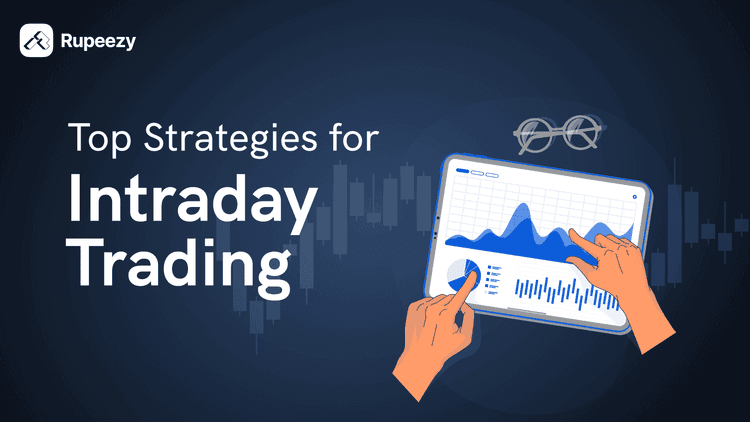VWAP Trading Strategy for Profitable Intraday Trades


00:00 / 00:00
In today's fast-paced stock market, VWAP Trading Strategy has become an important tool that is used with confidence by large institutional investors as well as small retail traders. It not only tells the average of the price, but also shows the real market trend in combination with the volume. Whether identifying the uptrend or downtrend with VWAP Intraday Strategy or finding the right entry-exit point, this strategy is helpful at every level. In this blog, we will understand in simple language what is VWAP Strategy, how it works and how better and smart decisions can be taken by adopting it in trading.
What is VWAP in Trading?
VWAP (Volume-Weighted Average Price) is a technical indicator that averages the traded prices of the day according to the trading volume. It not only shows the average price, but also includes how many shares or contracts were bought at that price.
In simple terms, VWAP is the “true average” that shows at what level big players (institutional traders) are entering or exiting the market. This is especially useful when you want to know the real direction of the market, whether prices are going up or down.
Difference between VWAP vs Simple Moving Average (SMA)
VWAP is based on both price and volume, and it resets every day so it is very suitable for intraday trading.
SMA, on the other hand, is just a simple average of closing prices and does not take volume into account so it is better for longer term trends.
Simple Analogy : Imagine you traded at ten different prices over the course of a day but some transactions were at a high volume. VWAP tells you what the “true average price by volume” was; this shows where the market was actually strong or weak.
How VWAP is Calculated
Many people think that the method of calculating VWAP (Volume Weighted Average Price) is very technical, but in reality it is quite simple. The formula for VWAP is as follows:
Formula VWAP :
VWAP = ?(Typical Price×Volume) / ? Volume
Where
Typical Price = (High + Low + Close) ÷ 3
That is, the average of the High, Low and Close of each time period (e.g. 1-minute, 5-minute) is calculated and multiplied by the volume of that period. Then the sum of these values for the entire day is taken and divided by the total volume.
Step-by-Step Example
Suppose the data for the first three 15-minute candles for a stock are as follows:
Candle 1: High ?250, Low ?245, Close ?248, Volume 1,200
Candle 2: High ?252, Low ?247, Close ?250, Volume 1,500
Candle 3: High ?255, Low ?249, Close ?253, Volume 1,800
1. Typical Price = (High + Low + Close) ÷ 3
C1 = (250 + 245 + 248) ÷ 3 = ?247.67
C2 = (252 + 247 + 250) ÷ 3 = ?249.67
C3 = (255 + 249 + 253) ÷ 3 = ?252.33
2. Addition of (Typical Price × Volume):
C1 = 247.67 × 1,200 = 2,97,204
C2 = 249.67 × 1,500 = 3,74,505
C3 = 252.33 × 1,800 = 4,54,194
Total = 11,25,903
3. Total Volume = 1,200 + 1,500 + 1,800 = 4,500 shares
4. VWAP = 11,25,903 ÷ 4,500 = ?250.20
This means the volume-weighted average price of this stock after the first 45 minutes of trading is ?250.20.
There is no need to do this calculation manually. On modern trading platforms like rupeezy, you can easily add the VWAP indicator to a chart of a 15-minute candle timeframe. Simply open the chart, set the timeframe to 15 Min, search for “VWAP” in the indicators list and apply. You will immediately see the real-time VWAP level.
VWAP Indicator Settings for Day Trading
To use VWAP effectively in intraday trading, it is best to set it to One-Day Reset. This means that the VWAP calculation restarts at the start of each new trading day, ensuring you see the latest volume-weighted average for the day.
Platform Variations :
TradingView : Search for “VWAP” in the indicator panel, and set Session to Day.
Rupeezy : Apply the VWAP indicator to our charting tool and view it in 15-minute or any preferred timeframe. Simply open a chart, set the timeframe and apply “VWAP”.
Advanced Settings Used by Pro Traders
Standard Deviation Bands : Identify volatility zones by adding 1 or 2 standard deviation bands around the VWAP.
Anchored VWAP : Anchoring the VWAP to a major event or important price point (e.g. Earnings Day, Breakout, Budget Day) to see the strength of the trend starting from that day.
Multiple Timeframe VWAP : Understand short-term and medium-term bias by combining 15-minute VWAP and 1-hour VWAP.
VWAP with Volume Profile : Combine VWAP with Volume Profile to find strong support and resistance zones.
Session-wise VWAP : Set separate VWAPs for morning, afternoon and closing sessions to track market behaviour at different times.
Why VWAP Works – The Institutional Angle
Big players in the market such as mutual funds, hedge funds, and proprietary trading firms always try to ensure that their orders do not have much impact on the market price. That is why they use VWAP (Volume Weighted Average Price) as a key tool.
Help in order execution : Executing a large order at once can have a big impact on the price, causing them to buy more or sell less. With the help of VWAP, these institutional investors execute their orders in small parts throughout the day, so that the price remains around the average level.
VWAP as a benchmark : VWAP is considered a measure of the quality of execution. If the average purchase price of a fund is below VWAP, it means that they have bought at a better price than the market average.
Example : Suppose a mutual fund wants to buy a large quantity of a stock. Their goal would be to buy below VWAP so that they get cheaper than the day's average. At the time of selling, they will try to sell above VWAP.
Opportunity for retail traders : When big players are constantly active at the VWAP level, the price reaction is more visible there. Retail traders can plan their entry and exit by looking at these activities happening around VWAP like trading by identifying a bounce or rejection near VWAP.
Core VWAP Trading Strategy
VWAP (Volume Weighted Average Price) is not just an indicator but a favorite tool of many professional and institutional traders. When used correctly, it can provide very accurate entry and exit points in intraday and short-term trading. On the Rupeezy trading platform, you can easily test all these strategies on the chart by applying VWAP with a 15-minute candle timeframe.
1 VWAP Intraday Strategy for Trend Trading
VWAP is used as a trend filter.
When the price is above VWAP, the market is considered to have a bullish bias.
When the price is below VWAP, the market is considered to have a bearish bias.
Traders can combine VWAP signals with MTF trading to increase buying power on intraday trends. This allows them to take larger positions when the price aligns with VWAP signals, potentially maximizing profits while adhering to margin requirements.
Example : On a 15-minute chart, if the price is consistently trading above VWAP and RSI is also above 50, then it is an indication of a bullish trend.
2 VWAP Mean Reversion Strategy
If the price has gone too far from VWAP (overextended), then often the price in the market reverts back towards VWAP.
This strategy works better in range-bound markets.
It is important to identify exhaustion candles and momentum fade.
Example : If Bank Nifty has gone far above VWAP and small body reversal patterns are forming in the candles, then a short sell can be made and a target can be set towards VWAP.
3 VWAP Pullback Entry Strategy
During a strong trend, the price often comes back to VWAP and new movement starts from there.
Many times big institutional investors add positions near VWAP.
Taking entry on pullback reduces risk and increases reward.
Example : Bank Nifty is trending upwards, price comes to VWAP and a bullish engulfing candle is formed. This is a good opportunity for a long entry.
4 VWAP Options Trading Strategy
VWAP can also be used for options scalping.
Avoid chasing when the underlying is far away from VWAP.
A low-risk entry can be taken when it comes close to VWAP.
Example : Buy Bank Nifty CE when the index bounces off VWAP and momentum starts to increase.
5 Advanced VWAP Strategy (Multi-Timeframe + Confluence)
Advanced traders use VWAP in conjunction with multi-timeframe analysis.
Set the bias by looking at the VWAP level on a higher timeframe (1 hour chart).
Take entry according to the same bias on a lower timeframe (15 minutes).
Adding support/resistance, Fibonacci levels and volume analysis further strengthens the strategy.
Common Mistakes When Using VWAP
VWAP is a powerful indicator, but it needs to be understood and used correctly. Many traders rely on VWAP without proper information, which can lead to wrong entries and huge losses.
Relying on VWAP alone : Taking entry or exit based on VWAP alone can be risky. Always use it in conjunction with other indicators, price action, support-resistance and volume analysis.
Choosing the wrong time frame : VWAP resets every day after the market opens. Hence applying it on multi-day charts can give false signals. A 15-minute candle time frame is best for intraday trading.
Taking trades every time VWAP is touched : Price touching VWAP does not always indicate a reversal or breakout. Taking trades on every touch without confirmation can lead to overtrading and increased losses.
Ignoring market trends : VWAP signals are accurate only when they are combined with the existing market trend. Taking trades against the trend increases the chances of losses.
Not customizing VWAP : Many pro traders use VWAP by customizing it to advanced versions such as session wise, anchored VWAP or multi-session VWAP. Relying on the same default settings can limit your strategy.
Conclusion
The VWAP trading strategy is one of the methods that many intraday and professional traders use on a daily basis. When used with the right time frame and settings, it helps a lot in understanding the market trend and deciding the right entry-exit points. But remember, not only the strategy, patience and experience of understanding the market is also important. Only continuous learning and practice leads to good results.
FAQs
Q1. What is VWAP in trading?
VWAP stands for Volume Weighted Average Price, which gives the average price of a stock by combining price and volume.
Q2. Which time frame is best for VWAP?
The 15-minute time frame is most commonly used in intraday trading.
Q3. Can VWAP be used for long-term trading?
VWAP is mostly used in intraday and short-term trading, it is less effective in long-term.
Q4. How is VWAP different from the moving average?
VWAP takes volume into account, while moving average only calculates the average of price.
Q5. Can I use VWAP on Rupeezy charts?
Yes, you can easily apply the VWAP indicator in Rupeezy charts and view it in real-time.
The content on this blog is for educational purposes only and should not be considered investment advice. While we strive for accuracy, some information may contain errors or delays in updates.
Mentions of stocks or investment products are solely for informational purposes and do not constitute recommendations. Investors should conduct their own research before making any decisions.
Investing in financial markets are subject to market risks, and past performance does not guarantee future results. It is advisable to consult a qualified financial professional, review official documents, and verify information independently before making investment decisions.
Open Rupeezy account now. It is free and 100% secure.
Start Stock InvestmentAll Category









